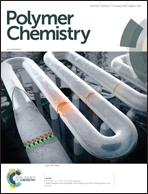In situ cross-linkable hyaluronic acid hydrogels using copper free click chemistry for cartilage tissue engineering†
Abstract
We report a biocompatible and in situ cross-linkable hydrogel derived from hyaluronic acid via a bioorthogonal reaction and confirm the clinical potential of our hydrogel through in vivo cartilage regeneration. Gelation is attributed to copper-free click reactions between an azide and dibenzyl cyclooctyne. HA-PEG4-DBCO was synthesized and cross-linked via 4-arm PEG azide. The effects of the ratio of HA-PEG4-DBCO to 4-arm PEG azide on the gelation time, microstructure, surface morphology, equilibrium swelling, and compressive modulus were examined. The potential of a hydrogel as an injectable scaffold was demonstrated by the encapsulation of chondrocytes within the hydrogel matrix in vitro and in vivo. The results demonstrated that the hydrogel supported cell survival, and the cells regenerated cartilaginous tissue. In addition, these characteristics provide potential opportunities for the use of injectable hydrogels in tissue engineering applications.

- This article is part of the themed collection: Most Downloaded 2018 Articles


 Please wait while we load your content...
Please wait while we load your content...